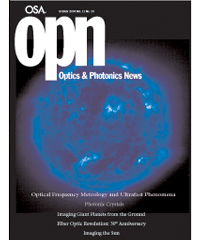
October 2000 Issue
- Towards the Ultimate Control of Light: Optical frequency metrology and the phase control of femtosecond pulses
- Photonic Crystals: Towards Large-Scale Integration of Optical and Optoelectronic Circuits
- Imaging Giant Extra-Solar Planets from the Ground
- The Clearest Glass in the World
- Imaging the Sun: In Extreme Ultraviolet and in X-Rays with Space borne Instruments
- Browse all Issues
Feature Articles
Towards the Ultimate Control of Light: Optical frequency metrology and the phase control of femtosecond pulses
In just the past year there has arisen a remarkable convergence of two seemingly disparate subfields of optical physics: precision optical frequency metrology and ultrafast phenomena. The former field is typified by the variety of spectroscopic and fundamental physical measurements that can be made using a continuous wave (CW) laser best described by its near delta-function frequency spectrum. In sharp contrast, the field of ultrafast phenomena encompasses the study of sub-picosecond events using laser pulses that approach the limit of time domain delta-functions. In fact, at this time state-of-the-art laser sources from these two fields share nearly the same delta-function “figure of merit” with frequency and temporal widths on the order of a few parts in 1015 hertz and seconds, respectively. In this article, we will present relevant details of these two subfields, then explore their connection, and finally highlight the most recent advances made possible by this surprising union.
by Scott A. Diddams, David J. Jones, Jun Ye, Tara M. Fortier, Robert S.Windeler, Steven T. Cundiff, T.W. Hänsch and John L. HallPhotonic Crystals: Towards Large-Scale Integration of Optical and Optoelectronic Circuits
Photonic crystals, since they were first proposed in 1987, have captured worldwide attention because of their intriguing potential to mold the flow of light. One particularly interesting aspect of photonic crystals is their unique capability to confine and control light at the single wavelength scale. This capability may lead to the exciting prospect of miniaturization and large-scale integration of optical and optoelectronic devices.
by Shanhui Fan and J. D. JoannopoulosImaging Giant Extra-Solar Planets from the Ground
The ultimate solution is to get above the atmosphere by putting a large telescope in space. Unfortunately, the existing Hubble Telescope is too small, and its mirrors emit heat. The diffraction-limited resolution provided by its 2.4 m aperture is not high enough to separate star and planet in the infrared, even were it equipped with detectors in the 5 to 10 micron range, and in the visible, it simply does not collect enough light. NASA’s Next Generation Space Telescope (NGST), on the other hand, with a diameter of 8 m, is specifically targeted for observations at the right wavelengths. NGST will be able to see giant planets orbiting at large separations around other stars, but it will not be operational for about a decade. Now in the planning stages is another NASA mission called Terrestrial Planet Finder, or TPF, which will extend the search to smaller Earth-like planets, and will look for key features in the spectra of any that it finds. In the case of our Earth, the infrared spectrum shows strong features of water, indicating the presence of oceans, and ozone. As far as we know, life is the only process that can maintain such a high abundance of ozone in the atmosphere. If we found another Earth-like planet with a similar spectrum, we would strongly suspect that it also supported life.
by Michael Lloyd-Hart and Roger AngelThe Clearest Glass in the World
Glass companies traditionally kept details of their advances secret to stay ahead of their competitors, so the news took time to reach the outside world. In July, Maurer told Stew Miller that Corning had reached the 20 dB/km target, but he didn’t talk to any other outsiders. Only at the end of September did Maurer make a public announcement, at a London meeting on trunk telecommunications.1 He reported a loss of 16 dB/km at the helium-neon wavelength, but said nothing of the glass composition or fabrication. Maurer was surprised to find no one else was close; he thought others had been guarding their own advances as carefully as Corning. Miller was surprised that Corning had reached 16 dB/km. Thinking Corning was reporting a better fiber—not just a better measurement of their first one—he went home and lit a fire under fiber development at Bell Labs, which had been in the shadow of hollow optical waveguides. Engineers at the British Post Office and STL also were impressed, and invited Maurer to their labs so they could verify his measurements.
by Jeff HechtImaging the Sun: In Extreme Ultraviolet and in X-Rays with Space borne Instruments
In recent years, thanks to data gathered by a series of successful satellites carrying a host of instruments to observe the Sun, many important advances have been made in understanding solar coronal activity. These data, examined with the aid of numerical computer modeling and alongside theoretical studies of solar phenomena, changed our view of the active Sun. Most of the satellites are still operational, and they continuously produce new images leading to new scientific results. Several new space missions to study the Sun are planned over the next decade by NASA, the European Space Agency (ESA), and Japan. One of these missions is the NASA Solar-Terrestrial Relations Observatory (STEREO), scheduled to be launched in 2004. STEREO will consist of two spacecraft that will observe the Sun at two separate vantage points in solar orbit and build a three-dimensional image of coronal mass ejections and solar disturbances.
by Leon Ofman
![Infinity Mirrored Room– Brilliance of the Souls 2014 by artist Yayoi Kusama. [© YAYOI KUSAMA]](https://opnmedia.blob.core.windows.net/$web/opn/media/images/articles/2024/0724/departments/202407-cover-web.jpg?ext=.jpg)
![An experimental scheme demonstrated by researchers at Princeton and Yale universities, USA, can convert physical noise into errors that can be corrected more easily. [F. Wojciechowski, Princeton University]](https://opnmedia.blob.core.windows.net/$web/opn/media/images/articles/2024/0624/departments/202406-cover-web.jpg?ext=.jpg)
